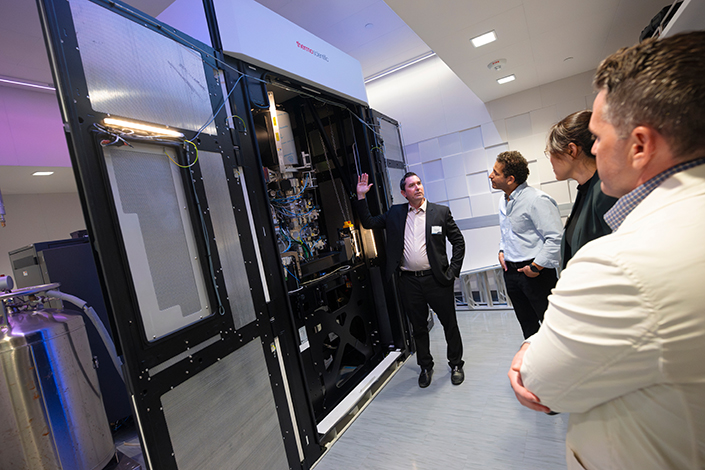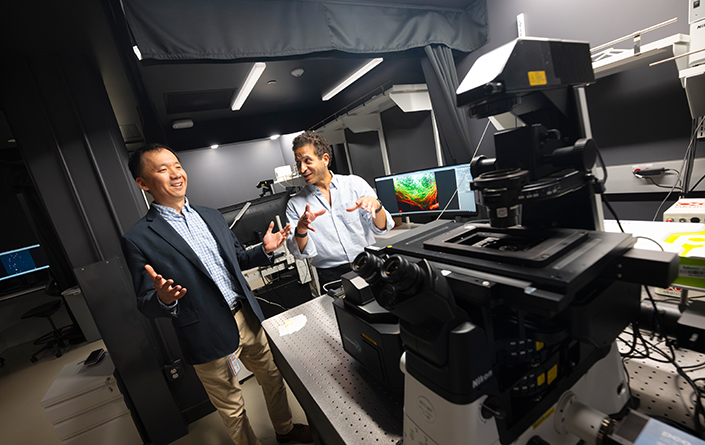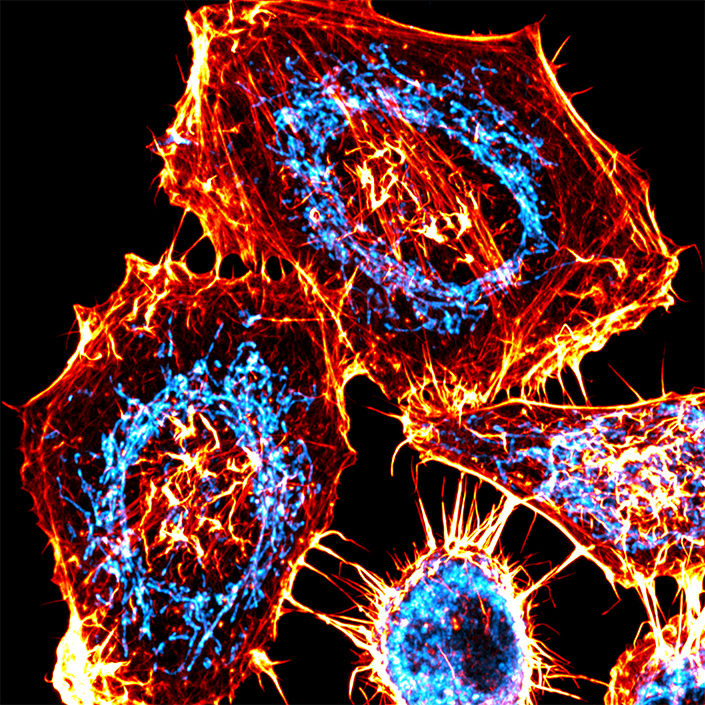Unique Technology Hub Set to Revolutionize Science, Education and Innovation
UC San Diego opens the Goeddel Family Technology Sandbox, an unrivaled cluster of state-of-the-art instruments for cutting-edge research and training
Story by:
Published Date
Article Content
To fully grasp the intricate details of the dynamics behind life’s mysteries like never before, science will need to zoom into the complex machinery underlying biological and physical processes like never before. And to meet the challenges of emerging diseases and risks to human health, scientists will need access to the most advanced tools available.
UC San Diego, along with partners Thermo Fisher Scientific and Nikon Instruments, took a critical step forward in that direction with the opening of one of the world’s most pioneering centers for technology across the biological, physical and health sciences.

At an August 29th ribbon-cutting event, the university officially opened the doors of the Goeddel Family Technology Sandbox, a hub that brings together cutting-edge instruments for science and education. While many top-notch scientific instruments are beyond the means of individual researchers, the Goeddel Family Technology Sandbox will spur unprecedented collaboration by enabling scientists across campus to access advanced technologies for their research.
“The Goeddel Family Technology Sandbox is a state-of-the-art facility that features a unique cluster of some of science’s most powerful instrumentation,” said UC San Diego Chancellor Pradeep K. Khosla. “These technologies will empower our world-renowned faculty and researchers to explore deeper than ever into the biological and physical worlds to rapidly advance scientific innovation. This is more critical than ever, as our world faces a broad range of urgent challenges that our scientists must address for future generations.”
Led by the School of Biological Sciences, the Goeddel Family Technology Sandbox will serve as a hub for industry collaborations as well as training courses and technology-based classes.
“At UC San Diego we emphasize pushing the frontiers of innovation and educational excellence and the Goeddel Family Technology Sandbox is yet another way we are doing that,” said Executive Vice Chancellor Elizabeth Simmons. “Not only does this facility launch an age of incredible research possibilities, but it opens educational and investigative opportunities for more of our undergraduates, graduates and postdoctoral scholars.”
Uri Manor, an assistant professor and faculty director for the Sandbox, says the new facility offers UC San Diego students unique opportunities to be trained on cutting-edge technologies that universities typically don’t offer (read more about Uri Manor’s journey to the Sandbox). Training on these technologies will stimulate their minds and creativity for scientific thinking that otherwise would not be possible.
School of Biological Sciences Dean Kit Pogliano and Professors Arshad Desai and Samara Reck-Peterson shaped the Goeddel Family Technology Sandbox as a nexus for industry collaboration. Named in honor of a $7.5 million gift from biotechnology industry leader and UC San Diego alumnus David Goeddel (’72), the Sandbox is a featured component of UC San Diego’s 10-year partnership with Thermo Fisher Scientific that opens access to the world’s most advanced scientific instrumentation. Through a separate partnership, a world-class Nikon Imaging Center is also featured inside the Sandbox.

“The Technology Sandbox is much more than a physical space — it’s a catalyst for collaboration and innovation,” said Vice Chancellor for Research and Innovation Corinne Peek-Asa. “By democratizing access to transformative technologies, this facility will provide researchers the resources and connections to bring innovative technology and medical treatments to the public realm, solving pressing national and global health problems. UC San Diego is at the forefront of startup company development nationally because of initiatives like this one.”
A complementary Technology Sandbox Fellows Program has been launched to advance postdoctoral scholars and other scientists through research, workshops and trainings, further advancing UC San Diego’s long history of making discoveries at the leading edge of science.
“The Goeddel Family Technology Sandbox is opening its doors in beautiful Bonner Hall — I can’t think of a better home since so many foundational achievements in molecular and cellular biology have occurred in that treasured building, which is celebrating its 60th anniversary this year,” said Pogliano. “Since my colleagues and I first shaped the vision for the Sandbox, we’ve always dreamed that it would serve as a research and education catalyst. Our ultimate goal is to expand access to advanced technologies with state-of-the-art tools that will transform both research and education.”
A look inside a cutting-edge technology cluster
The Goeddel Family Technology Sandbox features cryo-electron microscopy (cryo-EM) and cryo-electron tomography (cryo-ET), which in the past decade have become the world’s most powerful tools for analyzing the foundational properties of life with mind-boggling precision. These visualization tools use ultra-powerful microscopes to capture images of samples that are preserved at extremely low temperatures. Advancing over traditional imaging methods that require far more labor-intensive preparations, cryo-EM and cryo-ET samples are flash-cooled in a process that happens so fast that molecules are “frozen” in place. These technologies provide rich details of interactions and life functions at the most basic level.
“With these technologies we can look at cells and tissue, or bacteria that are infected by a virus, in order to really lift the hood and see what they are doing in their natural environment,” said Molecular Biology Professor Elizabeth Villa, a leader in new electron microscopy research. “What’s exciting about the Sandbox is that we’re trying to bring world experts in different techniques and combine them together under one roof. This will allow technologies that are complimentary to be used to solve problems in a completely different way.”
The Sandbox also offers a suite for mass spectrometry, an analytical tool that reveals the chemical makeup of substances. The “mass spec” process involves identifying the characteristics of individual molecules to precisely determine biological and chemical dynamics.
Such technologies allow scientists to witness living systems in-action at extremely high precision. They also help researchers analyze biological structures to more fully understand how such complicated processes work.
“This Sandbox represents what Thermo Fisher’s strategic partnership with UC San Diego is all about — bringing public and private partners together to innovate, collaborate and accelerate research that will help solve science’s most complex challenges,” said John Sos, Senior Vice President and President, Life Sciences Solutions, Thermo Fisher Scientific. “Together, we are empowering the next generation of brilliant minds to put their best ideas into practice with support from distinguished industry experts and leaders.”

Nikon Imaging Center Director Peng Guo (left) and Goeddel Family Technology Sandbox Faculty Director Uri Manor inside the Sandbox. Credit: Erik Jepsen/University Communications
Combining technologies in a shared space will open the door to a long-held dream of biologists: Bridging “worlds” across scale to analyze samples from molecules to the entire living cell. This capability will eventually help scientists with challenges such as watching the moment that a virus enters a cell; or help researchers describe how a mutant protein might be causing a disease; and they provide stunningly fresh viewpoints for designing new drugs.
“This space is really many micro environments that offer different types of technology, yet they are all connected,” said Reck-Peterson, who was instrumental in forging partnerships with Thermo Fisher and Nikon Instruments. “That was one of our goals with designing this space: to create places for scientists to interact. We’ve created a hub that has high-end technologies available for our entire scientific community; technologies that a single professor would not be able to buy for their own laboratory.”

Image scanning microscopy (an imaging technology approach that provides enhanced resolution) was used to image the actin cytoskeleton (orange) and mitochondria (cyan) in human cancer cells. Credit: Cara Schiavon (Manor Lab, UC San Diego)
Other Sandbox features include a world-class light microscopy suite featured in the Nikon Imaging Center, which allows scientists to visualize and study fine details of samples by using microscopes that focus light through lenses to illuminate and magnify specific properties of microscopic organisms; and electron microscopy, a method that uses beams of electrons to scan and highlight areas of interest, resulting in high-resolution images.
“The Goeddel Family Technology Sandbox is extremely unique — it might be the only one in the world that has all of these technologies under one roof,” said Manor. “You can think of this as a natural zone of innovation driven by the interactions of diverse disciplines. By bringing together all these different technologies and expertise we’re going to have bursts of innovation and invention that would not have happened otherwise. Just having this technology accessible to all UC San Diego labs is going to be a major game changer.”
Desai says the Sandbox also was set up for undergraduate education to expose students to the most modern technologies that are propelling research, both in academia and industry.
“If you look at the history of research in biology and medicine, it’s really driven by new ways of seeing things,” said Desai. “So our vision was to democratize access to new technologies that that are emerging to explore complex biological systems. Our hope is that in five years we will see all kinds of new science emerge from this site’s equipment and expertise. It’s been quite a journey and we are very excited to see where we are now and look forward to how the Sandbox will drive research on campus.”
Share This:
Stay in the Know
Keep up with all the latest from UC San Diego. Subscribe to the newsletter today.



